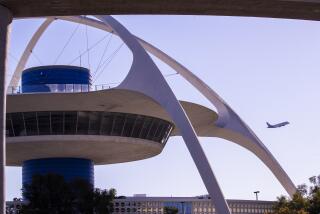Near-Misses Spark LAX Review
- Share via
WASHINGTON — After two midair incidents in as many weeks near Los Angeles International Airport, the Federal Aviation Administration said Friday that it is considering changes to a controversial air traffic procedure.
Currently, small private planes are allowed to fly a route that skirts the airport shoreline. Large jets taking off over the ocean are ordered to stay under them to avoid collisions. As recently as a week ago, the FAA had said the procedure was safe, despite a near-collision Sept. 26 between a FedEx Airbus A310 and a Piper Comanche.
However, FAA officials say they are reviewing the procedure after another incident Wednesday, when the pilot of a small plane went into a nose dive in the mistaken belief he was about to be hit by a Boeing 777.
According to the agency, the pilot of a single-engine Grumman AA-5 was crossing near the airport at 2,500 feet about 5:20 pm Wednesday, when he spotted Denver-bound United Flight 346 climbing rapidly at him and apparently panicked.
Unaware that the 777 was about to level off at 2,000 feet, the pilot put his little four-seater into a steep, 900-foot dive and came too close to the big jet. The two planes passed within a mile of each other horizontally, and 200 feet vertically, with the jet traveling above 200 mph.
“Obviously, this route is affecting pilots and controllers in that there is confusion in communications,” said FAA spokesman Jerry Snyder. FAA air traffic specialists “are going to look at several options to better facilitate safety and efficiency,” Snyder added.
The FAA classified Wednesday’s incident as an error by the pilot of the Grumman. The previous week’s incident, more serious because the two planes came closer, was blamed on a controller’s mistake.
Controllers, airlines and airline pilots want the FAA to move the crossing route used by small planes. Mike Foote, head of the National Air Traffic Controllers Assn. at LAX, has termed the procedure “very, very dumb” and has also called on the FAA to hire additional controllers to deal exclusively with small planes near LAX.
“Small airplanes and big airplanes just don’t mix,” said John Russell, a Boeing 757 captain and Western region safety chairman for the Air Line Pilots Assn. “It’s as dangerous for the large aircraft as it is for the small ones, even though [jets] have collision avoidance warning systems.”
Pilots Prefer Consistent Procedure
Russell said airline pilots would prefer to have a single procedure for departures from LAX, one that would allow them to quickly climb to 3,000 feet or higher. Now, when a little plane is crossing, jet pilots are required to level off momentarily at 2,000 feet to keep a safe distance. Having two procedures can be confusing for pilots, who must juggle dozens of tasks during takeoff.
Indeed, during Wednesday’s incident, the United pilot initially assumed his flight was cleared to climb to 3,000 feet, until a controller quickly corrected him.
But private pilots--who have been progressively squeezed out of much of the busy Southern California airspace--would be loath to relinquish the current route, which allows convenient access between Santa Monica, Hawthorne and other local airports.
FAA spokesman Snyder said the agency is considering a range of options to address the problem. Controllers said these range from tinkering with the existing route to requiring small aircraft to cross at a much higher altitude of 4,000 feet farther west of the airport. Snyder said the review could take several months.
Private planes and large jets have collided over Southern California in the past.
In 1986, an Aeromexico DC-9 preparing to land at Los Angeles collided with a Piper PA-28 over Cerritos, killing 82 people. The National Transportation Safety Board concluded that shortcomings in air traffic control were the primary cause of the accident.
More to Read
Sign up for Essential California
The most important California stories and recommendations in your inbox every morning.
You may occasionally receive promotional content from the Los Angeles Times.













